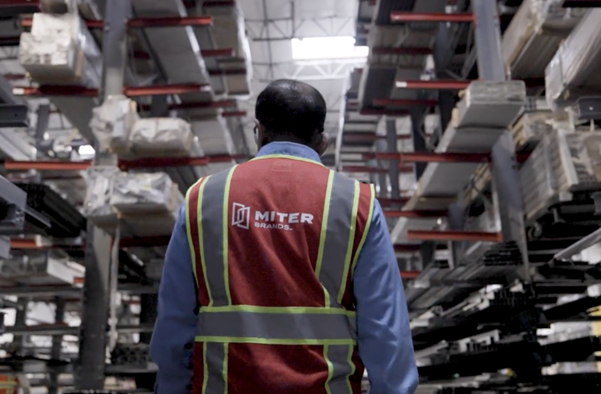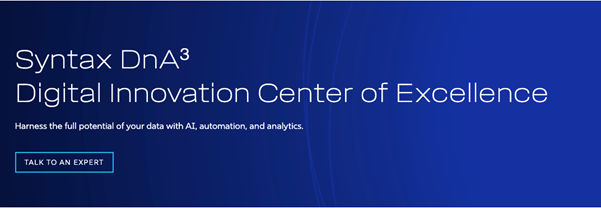Several years ago, Syntax’s leadership set out with a bold vision: to develop a strategic, market–leading roadmap for embedding generative AI software into every corner of our business. That vision wasn’t about chasing hype. It was about anticipating the transformative shift GenAI would bring and ensuring Syntax was ready to harness its full potential.
Today, that plan is no longer a theory. It’s becoming reality in ways that are already reshaping how we innovate, deliver, and create value for our customers. To demonstrate what’s possible with GenAI and how Syntax is leading the charge, we’re pulling back the curtain on real‑world use cases from across our global operations.
This post marks the first installment in our new blog series, Insights from Syntax’s Global Business Innovation, a behind–the–scenes look at how we’re using AI software to accelerate productivity, unlock new opportunities, and stay at the forefront of an industry in motion.
There’s been a persistent truth in technology circles for decades: demand for software engineers far outweighs what IT can deliver.
Five years ago, Microsoft’s Charles Lamanna quantified it as a 5x faster demand for mobile apps than IT departments could deliver. It’s been a structural bottleneck that shaped hiring strategies, outsourcing trends, and the rise of low code platforms.
In that world, developers really were the new kingmakers, a term from RedMonk’s Stephen O’Grady that echoed in the corridors of the tech industry for more than a decade. The logic was simple: if coding talent was scarce and you had it, you could out-innovate competitors and build a moat (a durable technological advantage that kept rivals at bay) around your business.
But here’s the twist: Generative AI is rewriting that equation entirely.
Moats have been steadily shrinking, and in today’s hyper‑competitive, AI‑driven, open source dominated landscape, they’ve all but disappeared.
The Driving Force of AI Software
Tools like GitHub, Copilot, Devin, Cursor, Claude, and OpenAI’s suite have given developers the ability to produce clean, functional code in a fraction of the time. GenAI coding assistants are breaking through the traditional bottleneck, not by replacing developers, but by multiplying their productivity.
Google’s Sundar Pichai puts the software engineering productivity boost at 10%, while GitHub CEO Thomas Dohmke sees developers completing tasks up to 55% faster. Microsoft’s Satya Nadella says as much as 30% of Microsoft code is now written by AI.
That’s transformative; but it’s also leveling the playing field. When everyone can accelerate software delivery at this scale, speed alone stops being the differentiator. Your competitors can use the same copilots, the same large language models, and the same open-source kits.
What Are Moats Today?
Today’s moat rests on mastering three interlocking pillars:
1. Deep Domain Expertise and Strategic Portfolio Buildout
Anyone skilled can use AI software to produce code. Not everyone can embed deep industry context into each product decision. In a new (soon agentic) digital world, your IP strategy needs to be laser-focused on industry-specific domain expertise and addressing white spaces.
Domain expertise lets you prioritize the right problems to solve (the ones customers care about enough to pay for). It’s the sieve that filters AI’s raw productivity into real business outcomes. It’s about codifying sector-specific insights into product roadmaps, prioritizing features that matter most to your customers, and building solutions that competitors without that knowledge can’t easily replicate. Domain expertise shapes your portfolio in ways generic tools and templates never can.
2. GenAI-driven Software Product Engineering
This is about more than speeding up coding tasks. It’s about retooling your App Factory (people, processes, and pipelines) to integrate AI from requirements gathered through testing, deployment, documentation, and even support.
Speed and quality are no longer tradeoffs; with GenAI powered development, organizations can design, build, test, and release software in compressed cycles without sacrificing stability or security. The winners will run a modern, automated, and agile software life cycle that uses AI to eliminate bottlenecks, improve code quality, and free human creativity for the highest impact work.
3. Go-To-Market Excellence
Even the best GenAI enhanced software will fail commercially without disciplined GTM. This covers everything from positioning and pricing to enablement and post-sale adoption.
Too many companies still treat GTM as a downstream activity. In reality, it needs to be an equal node alongside engineering and portfolio management, feeding into product decisions early, ensuring that what you build is easy to sell and even easier to adopt.
Go-To-Market excellence is about rapid delivery, closing feedback loops, iterating based on user data, and mobilizing sales, marketing, and customer success teams in sync with product development. It’s a discipline of speed to value, and the ability to repeat that cycle faster than competitors.
How MITER Brands Benefits from GenAI
Discover how Syntax is helping MITER Brands, a leading manufacturer of residential windows and doors, tap into the power of GenAI to enhance sales and marketing efficiency, improve customer interactions, and rapidly scale its business.
Syntax Leads the Way
At Syntax, our deep domain expertise is the result of decades spent delivering ERP, cloud, and managed services across complex industries like manufacturing, construction, and the public sector. It allows us to design solutions infused with real‑world, industry‑specific context.
We’ve modernized our engineering processes with GenAI‑powered development pipelines, intelligent automation, and cloud‑native architectures that accelerate delivery while maintaining enterprise‑grade quality and security. And we bring these innovations to market with speed and precision by tightly aligning product, sales, and customer success teams to ensure every enhancement is guided by direct customer feedback and delivers measurable value.
This combination of domain insight, advanced engineering, and rapid go‑to‑market execution is how we sustain our own competitive advantage in today’s fast‑moving technology landscape—and it’s the same playbook we bring to our customers. In a world where technology alone is no longer a moat, Syntax empowers organizations to build an edge that’s resilient, repeatable, and impossible to copy.
Tap into Syntax DnA³ to modernize processes, streamline operations, and make faster, smarter decisions with AI software, automation, and analytics.
If you’re ready to turn AI‑powered productivity into lasting market leadership, we’re ready to help you make it happen. Contact us today to start building your new moat.
And stay tuned for our next post in the “Insights from Syntax’s Global Business Innovation” blog series.
Author

Matthias Steiner
Sr. Director of Global Innovation, Syntax
Matthias Steiner, Sr. Director of Global Business Innovation at Syntax with over 20 years of enterprise IT experience, is an impact-driven senior product manager with a proven record of developing innovative software products and taking them to market.
Thriving in execution-focused leadership roles and scaling up global teams at the intersection of software engineering, GTM, and product marketing, Matthias is also well-versed in technology topics and C-level business conversations. He guides organizations in building AI-ready, resilient, and future-proof data foundations that deliver measurable business impact.
Matthias Steiner l LinkedIn



